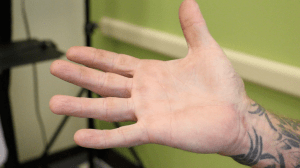Hand Surgery Gets Roofer Back on the Job
- What is Carpal Tunnel Syndrome?
- What is the Hamate Bone?
- Workplace Advantage to Get Duane Back on the Job
- What Are Treatment Options for Carpal Tunnel Syndrome?
- How Do You Treat a Fractured Hamate Bone?
Years of work as a roofer took their toll on Duane’s hands. Severe carpal tunnel syndrome caused him chronic pain, tingling, and weakness in his hands, making it difficult to perform his job. When Duane suffered an injury on a job site, fracturing the hamate bone in his hand, he could no longer work at all.
In an effort to treat his injury and get back on the job as quickly and safely as possible, Duane turned to Alan W. Christensen, M.D., a board certified orthopaedic surgeon at Orlando Orthopaedic Center specializing in hand and upper extremity surgery. After a comprehensive evaluation, Dr. Christensen recommended surgery to remove the fractured bone and alleviate the carpal tunnel at once.
“The entire procedure was great from start to finish,” says Duane. “Everyone at Orlando Orthopaedic Center was very professional and friendly. It was an amazing experience.”
What Is Carpal Tunnel Syndrome?

Duane at work following a successful hand surgery procedure with Dr. Christensen.
Carpal tunnel syndrome is one of the most common nerve disorders diagnosed today, a condition that impacts between four and ten million people.
Carpal tunnel syndrome is characterized by progressive numbness and eventually weakness in the hand caused by increased pressure on the median nerve in the wrist. The carpal tunnel itself is a narrow space through which nine tendons and the median nerve cross the wrist to reach the hand. Carpal tunnel syndrome can be treated effectively with medications, splinting, injections and, if all other treatment methods fail, surgery.
The Hook of the Hamate Bone in the Hand
The hamate bone is a unique bone among the eight bones making up the wrist. Its unusual shape which includes a tiny projection on one side has given rise to the term “hook of the hamate.” The hook provides a bridge for the tendons and ligaments in the wrist as they move through the hand.
A fractured hamate bone is a rather rare occurrence and accounts for less than 2% of all wrist bone fractures. Most hamate bone breaks affect the hook and primarily happen to athletes whose sport requires strong gripping of equipment like in baseball, tennis, and hockey. Diagnosing and treating a broken hamate bone can be challenging.
Workforce Advantage to Get Duane Back on the Job
Orlando Orthopaedic Center has served the worker’s compensation community for over 35 years offering both patients and business partners a full range of orthopaedic services on-site. Moreover, their physicians are committed to providing the best care and management for injured workers and help to resolve the most complicated medical cases with proficiency and dedication.
“I work for a roofing supply company,” says Duane. “I load shingles on to rooftops for commercial and residential properties. I came to Orlando Orthopedic Center because I had a fractured hamate bone and severe carpal tunnel syndrome.”
What Are Treatment Options for Carpal Tunnel Syndrome?
 Treatments for carpal tunnel syndrome are designed to decrease the pressure on the median nerve thereby reducing pain, tingling, and numbness. The earlier patients seek out treatment the higher their chances of alleviating symptoms and preventing long-term damage to the median nerve in the hand.
Treatments for carpal tunnel syndrome are designed to decrease the pressure on the median nerve thereby reducing pain, tingling, and numbness. The earlier patients seek out treatment the higher their chances of alleviating symptoms and preventing long-term damage to the median nerve in the hand.
Conservative treatments include:
- The use of a splint (especially to keep the wrist straight at night)
- Rest
- Changing the nature of the repetitive activity causing the pain
- Acetaminophen and non-steroidal anti-inflammatory medications to control inflammation and pain
- Steroid injections
If non-surgical methods fail to provide relief of symptoms, then carpal tunnel release surgery may be recommended. This minimally-invasive surgery involves cutting the ligament to lower the pressure inside of the tunnel, thus taking pressure off of the median nerve allowing the nerve to heal.
How Do You Treat a Fractured Hamate Bone?
Treating a broken hamate bone can be challenging at times depending on whether the hamate bone has been displaced within the wrist or not. A cast can be used to immobilize the broken bone, but it is not always effective and has shown unreliable results. According to Dr. Christensen, the most practical and efficient treatment is to remove the fractured hook of the hamate surgically.
“A hamate fracture usually won’t heal on its own,” says Dr. Christensen. “We typically do surgery to take it out. Duane got back to work three weeks after his surgery.”
“The day of surgery I had a little anxiety with the procedure coming up,” says Duane. “They took great care of me. They made me comfortable. Everybody was very professional, and everything was great from start to finish, from the secretaries to the doctor. They are very kind, nice people, easy to get along with and easy to deal with.”
Due to the surgical incision, the hand may be tender and weak right after surgery which can limit grip strength. However, the rehabilitation and healing process under the guidance of a certified physical therapist will have most patients back to normal functioning within two to four weeks.
“Dr. Christensen went in (during surgery) and fixed it all in one shot,” says Duane. “He removed the hook of the hamate bone and did the carpal tunnel release on top of that. The turnaround time was short. I was back to work within three weeks. Being back to full duty was great. Getting back to work in a timely manner was my concern and not having this drag on. I got what I wanted out of it.”


